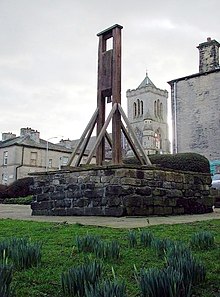
Back Gibet d'Halifax French Patibolo di Halifax Italian ハリファックス断頭台 Japanese 핼리팩스 지빗 Korean 哈利法克斯斷頭台 Chinese
53°43′25″N 1°52′03″W / 53.72372°N 1.8674°W

The Halifax Gibbet /ˈhælɪfæks ˈdʒɪbɪt/ was an early guillotine used in the town of Halifax, West Yorkshire, England. Estimated to have been installed during the 16th century, it was used as an alternative to beheading by axe or sword. Halifax was once part of the Manor of Wakefield, where ancient custom and law gave the Lord of the Manor the authority to execute summarily by decapitation any thief caught with stolen goods to the value of 131⁄2d or more (equivalent to £10 in 2023), or who confessed to having stolen goods of at least that value. Decapitation was a fairly common method of execution in England, but Halifax was unusual in two respects: it employed a guillotine-like machine that appears to have been unique in the country, and it continued to decapitate petty criminals until the mid-17th century.
The device consisted of an axe head fitted to the base of a heavy wooden block that ran in grooves between two 15-foot-tall (4.6 m) uprights, mounted on a stone base about 4 feet (1.2 m) high. A rope attached to the block ran over a pulley, allowing it to be raised, after which the rope was secured by attaching it to a pin in the base. The block carrying the axe was then released either by withdrawing the pin or by cutting the rope once the prisoner was in place.
Almost 100 people were beheaded in Halifax between the first recorded execution in 1286 and the last in 1650, but as the date of the gibbet's installation is uncertain, it cannot be determined with any accuracy how many individuals died via the Halifax Gibbet. By 1650, public opinion considered beheading to be an excessively severe punishment for petty theft; use of the gibbet was forbidden by Oliver Cromwell, Lord Protector of the Commonwealth of England, and the structure was dismantled. The stone base was rediscovered and preserved in about 1840, and a non-working replica was erected on the site in 1974. The names of 52 people known to have been beheaded by the device are listed on a nearby plaque.